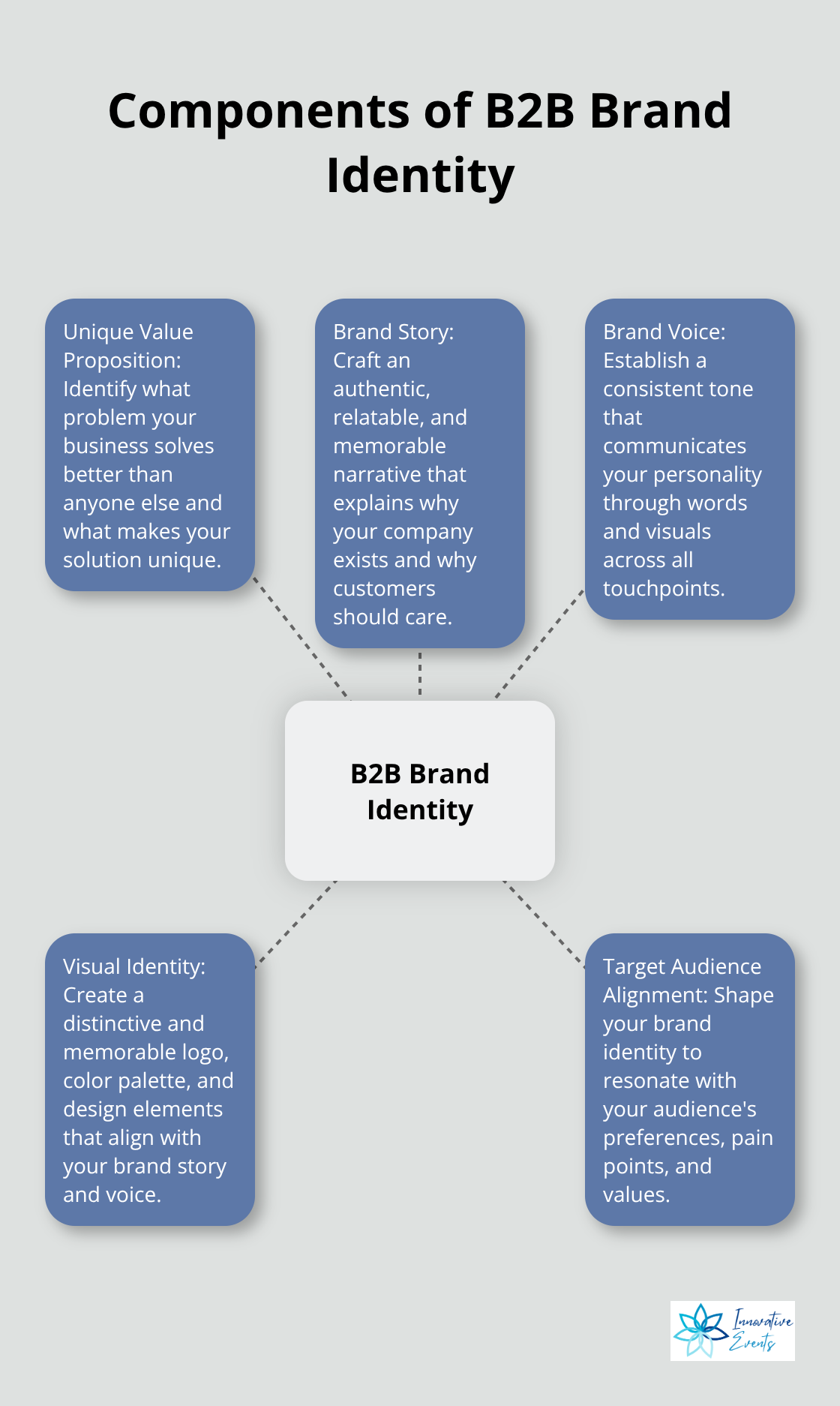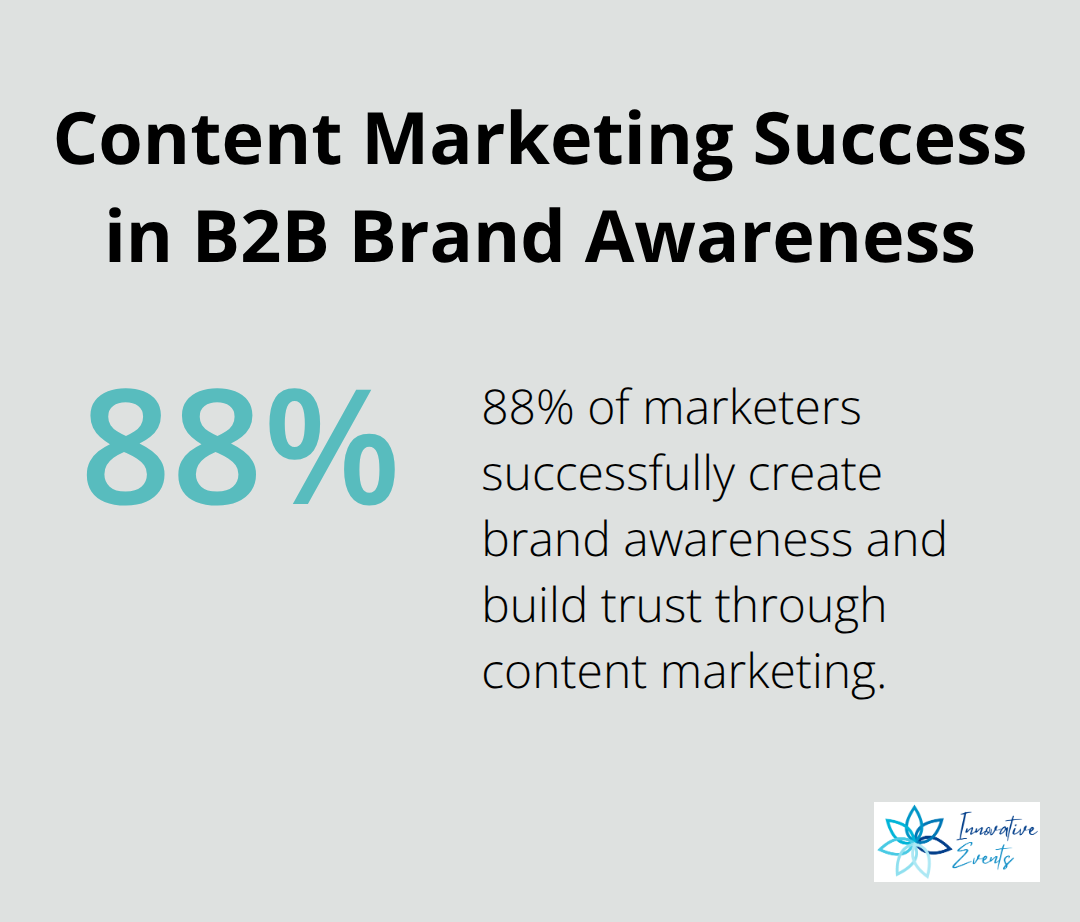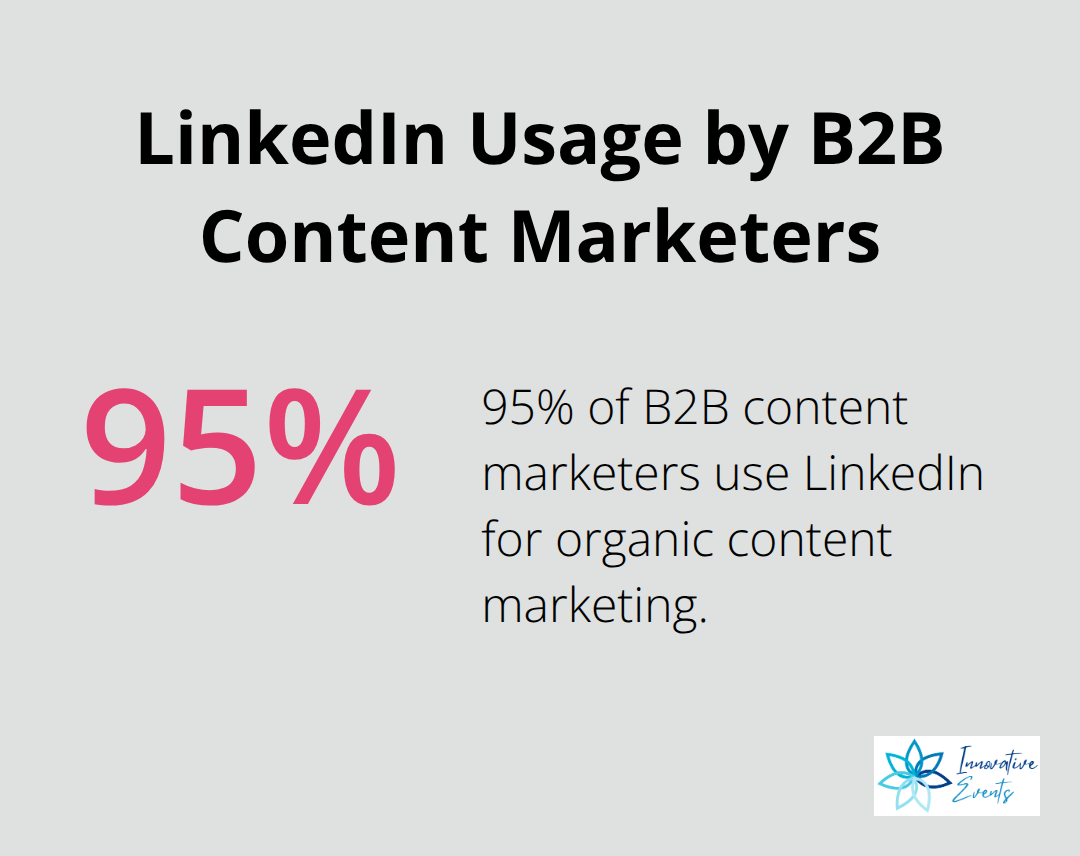B2B brand awareness is the foundation of successful business relationships. It’s the key to standing out in a crowded marketplace and attracting the right clients.
At Innovative Events, we know that a powerful B2B brand awareness strategy can transform your company’s growth trajectory. This blog post will guide you through the essential steps to build and implement a strategy that resonates with your target audience.
Defining Your B2B Brand Identity
Your B2B brand identity forms the foundation of a successful brand awareness strategy. It’s not just about a logo or tagline; it’s about creating a distinct personality that resonates with your target audience and sets you apart from competitors.
Uncover Your Unique Value Proposition
Your unique value proposition (UVP) makes your business irreplaceable. To identify it, analyze your strengths, your competitors’ weaknesses, and your customers’ needs. Ask yourself: What problem do we solve better than anyone else? What makes our solution unique?
For example, Salesforce’s UVP isn’t just about providing CRM software; it’s about “empowering companies to connect with their customers in a whole new way.” This UVP addresses a specific need and highlights their unique approach.
Craft Your Brand Story
Your brand story should be authentic, relatable, and memorable. It’s not a chronological history of your company; it’s the narrative that explains why you exist and why customers should care.
Take Patagonia, for instance. Their brand story revolves around environmental activism and outdoor adventure. This narrative permeates everything they do, from product design to marketing campaigns, creating a strong emotional connection with their audience.
Establish a Consistent Brand Voice
Your brand voice communicates your personality through words and visuals. It should remain consistent across all touchpoints (from your website to your email signatures).
Consider MailChimp’s brand voice. They use a conversational, sometimes quirky tone that makes complex tech concepts accessible. This voice remains consistent across their platform, documentation, and marketing materials, making their brand instantly recognizable.
Create a Visual Identity
Your visual identity (including your logo, color palette, and design elements) should align with your brand story and voice. It should be distinctive and memorable, helping your brand stand out in a crowded marketplace.
IBM’s visual identity, for example, has evolved over the years while maintaining its core elements. Their iconic eight-bar logo and use of blue convey trust and stability, perfectly aligning with their brand positioning in the tech industry.
Align Your Brand with Your Target Audience
Your brand identity should resonate with your target audience. Research your audience’s preferences, pain points, and values. Use this information to shape your brand identity in a way that appeals directly to them.
For instance, if your target audience values innovation and cutting-edge solutions, your brand identity should reflect these qualities through modern design elements and forward-thinking messaging.
As we move forward, we’ll explore how to leverage this well-defined brand identity in your content marketing efforts, ensuring your brand message reaches and resonates with your target audience effectively.

How to Create Content That Builds B2B Brand Awareness
Content marketing stands as a powerful tool for building B2B brand awareness. Strategic content can transform a company’s visibility and reputation in the marketplace.
Align Your Content with Your Brand Identity
Your content strategy should extend your brand identity directly. Every piece of content you produce must reflect your unique value proposition, brand story, and voice. This consistency reinforces your brand identity and makes your content instantly recognizable to your audience.
For example, if your brand identity emphasizes innovation and forward-thinking solutions, your content should focus on cutting-edge industry trends, new technologies, and thought leadership pieces that showcase your expertise.
Focus on Quality Over Quantity
In the B2B space, high-quality, informative content reigns supreme. Your audience seeks valuable insights that can help them solve business problems or make informed decisions. Prioritize depth and accuracy over producing a high volume of superficial content.
A study by the Content Marketing Institute found that 88% of marketers have successfully reached their goals of creating brand awareness and building trust through content marketing. This approach builds trust and positions your brand as a valuable resource in your industry.

Diversify Your Content Formats
Different segments of your audience prefer to consume content in different ways. By diversifying your content formats, you can reach a wider audience and reinforce your message through multiple channels.
Here are some effective content formats for B2B brand awareness:
- Blog posts: Regular, in-depth articles on industry topics can boost your SEO and establish thought leadership.
- Whitepapers and eBooks: These long-form pieces allow you to explore complex topics in detail, showcasing your expertise.
- Case studies: Real-world examples of how your solutions have helped other businesses can serve as powerful social proof.
- Videos: According to Wyzowl, 86% of businesses use video as a marketing tool (with 87% reporting a positive ROI).
- Podcasts: With the growing popularity of audio content, podcasts can help you reach busy professionals during their commute or downtime.
Leverage Data and Research
Incorporating original research or data into your content can significantly boost its value and shareability.
Try conducting industry surveys, analyzing trends in your customer data, or partnering with research firms to produce unique insights that your audience can’t find elsewhere.
Optimize for Search Engines
While creating high-quality content is essential, ensuring that your target audience can find it is equally important. Implement SEO best practices in your content strategy:
- Conduct keyword research to understand what your audience searches for.
- Optimize your content with relevant keywords, meta descriptions, and title tags.
- Create a logical site structure and internal linking strategy to help search engines understand your content.
A study found that B2B SaaS websites offering original research increased organic traffic on average by 29.7% vs. 9.3% for those that didn’t, making SEO a critical component of your content strategy.
These strategies can help you create a content marketing approach that not only builds brand awareness but also establishes your company as a trusted authority in your industry. Consistency and quality form the foundation of long-term success in content marketing for B2B brand awareness. As we move forward, we’ll explore how to maximize digital channels to amplify your brand’s visibility and reach your target audience effectively.
How to Amplify Your B2B Brand Online
Supercharge Your Website’s SEO
Your website often serves as the first point of contact for potential clients. Optimizing it for search engines is essential. Start with thorough keyword research to understand your target audience’s search habits. Tools like SEMrush or Ahrefs provide valuable insights into search volumes and competitor rankings.
Integrate your key terms naturally into your website’s content, meta descriptions, and title tags. Search engines now prioritize user experience, so ensure your site loads quickly, works well on mobile devices, and offers valuable, easy-to-navigate content.
A study found that in 2023, organic and paid search combinations made up 80% of all trackable website visits, an increase of 20% since 2019. This highlights the importance of a solid SEO strategy. Regular updates with fresh, relevant information can boost your search rankings and encourage repeat visits.
Harness Social Media Power
Social media platforms offer unparalleled opportunities for B2B brand visibility. LinkedIn stands out as a powerhouse for B2B marketing, with 95% of B2B content marketers using it for organic content marketing (according to the Content Marketing Institute).
Don’t just post and hope for the best. Engage your audience by sharing valuable insights, participating in industry discussions, and showcasing your company culture. Use LinkedIn’s native video feature to share quick tips or behind-the-scenes glimpses – videos on LinkedIn get shared 20 times more than any other type of content.

Twitter can also prove valuable for B2B brands. Use it to share industry news, engage in real-time conversations, and build relationships with influencers in your field. Include relevant hashtags to increase your visibility.
Leverage Targeted Paid Advertising
While organic reach matters, paid advertising can significantly boost your brand visibility. Platforms like Google Ads and LinkedIn Ads allow you to target specific demographics, job titles, and even companies.
When creating your ads, address your audience’s pain points and explain how your solution helps. Use strong calls-to-action and optimize your landing pages for conversions.
A report predicts a 3.8% rise in B2B digital ad spending in the US for 2023, with even healthier growth expected in the coming years. This trend underscores the growing importance of paid digital advertising in the B2B space.
Implement Email Marketing Campaigns
Email marketing remains a powerful tool for B2B brand awareness. Create targeted email campaigns that provide value to your subscribers. This could include industry insights, product updates, or exclusive offers.
Personalize your emails based on subscriber behavior and preferences. Use A/B testing to optimize your subject lines, content, and send times. According to a study by Campaign Monitor, segmented email campaigns can lead to a 760% increase in revenue.
Collaborate with Industry Influencers
Partnering with industry influencers can expand your brand’s reach and credibility. Identify thought leaders in your field and explore collaboration opportunities (such as co-created content, webinars, or podcast appearances).
These partnerships can expose your brand to new audiences and lend additional authority to your messaging. A study by TopRank Marketing found that 74% of B2B marketers believe that influencer marketing improves customer and prospect experience with their brand.
Final Thoughts
A powerful B2B brand awareness strategy requires careful planning and consistent execution. Companies must define their brand identity, leverage content marketing, and maximize digital channels to create a strong presence in the competitive B2B landscape. A well-crafted brand identity serves as the foundation for all marketing efforts, while content marketing establishes thought leadership and builds trust with potential clients.
The digital realm offers numerous opportunities to boost brand visibility through SEO, targeted advertising, and strategic use of social media platforms. Email marketing and influencer partnerships further amplify your message and help you connect with your target audience. A successful B2B brand awareness strategy adapts to the evolving business landscape, requiring regular evaluation and refinement.
At Innovative Events, we understand the importance of a strong brand presence in the B2B space. Our personalized, integrative lifestyle program for busy executives demonstrates how a well-defined brand can address specific needs in the market. We invite you to explore how our approach can help elevate your brand and drive business growth.

